20 March 2017
Chocolate makers, chocolatiers, pastry chefs and home cooks alike strive to master it. However, failure may lead to much strife and be potentially off-putting to the discerning chocolate connoisseurs and aficionados. To clarify upfront, I’m not referring to the state of one’s emotions. In the chocolate world, “temper” is what makes chocolate aesthetically and structurally appealing to the learned consumer.
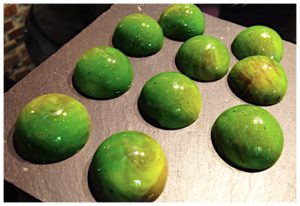 I’ve mentioned the term in numerous posts, in connection with well made chocolates. Now, let’s aim to explore the What, Why and How of “temper”.
I’ve mentioned the term in numerous posts, in connection with well made chocolates. Now, let’s aim to explore the What, Why and How of “temper”.
What
Simply put, tempering chocolate is a chemical process affecting the fat component in chocolate – the cocoa butter. This process is aided by time, temperature and stirring.
Cocoa butter contains several different types of cocoa butter crystals including alpha, beta and gamma crystals. When chocolate is tempered, the formation of beta crystals is preferentially selected. These beta crystals align and form a stable, tightly bound structure throughout the chocolate.
Why
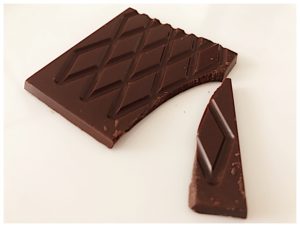 Tempering enhances the structure of chocolate. Because the beta crystals are tightly bound, it takes more physical effort to pull them apart. This is why when well tempered chocolate is broken apart, you hear the characteristic snap. Untempered or poorly tempered chocolate breaks apart easily and may crumble.
Tempering enhances the structure of chocolate. Because the beta crystals are tightly bound, it takes more physical effort to pull them apart. This is why when well tempered chocolate is broken apart, you hear the characteristic snap. Untempered or poorly tempered chocolate breaks apart easily and may crumble.
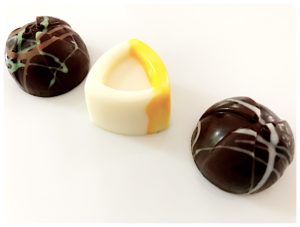 Tempering enhances the appearance of chocolate. The stable alignment of the beta crystals results in the glossy, shiny sheen on the surface of well tempered chocolate. Untempered or poorly tempered chocolate appears dull or matt, and over time, white or light brown patches may start to appear. The latter is caused by a phenomenon called fat bloom, whereby the less stable alpha crystals deposit on the surface of the chocolate.
Tempering enhances the appearance of chocolate. The stable alignment of the beta crystals results in the glossy, shiny sheen on the surface of well tempered chocolate. Untempered or poorly tempered chocolate appears dull or matt, and over time, white or light brown patches may start to appear. The latter is caused by a phenomenon called fat bloom, whereby the less stable alpha crystals deposit on the surface of the chocolate.
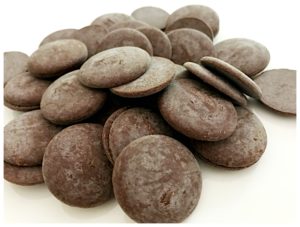 Tempering enhances the mouthfeel of chocolate. The beta crystals are the finest of the cocoa butter crystals. Together with variabilities in the production process namely the size of the winnowing sieve and duration of conching, tempering creates the smooth and even texture of chocolate.
Tempering enhances the mouthfeel of chocolate. The beta crystals are the finest of the cocoa butter crystals. Together with variabilities in the production process namely the size of the winnowing sieve and duration of conching, tempering creates the smooth and even texture of chocolate.
Tempering increases the melting point of chocolate, thereby improving its resistance to melting. Because the beta crystals in tempered chocolate are tightly interlocked, it takes a higher temperature to pull them apart.
How
Tempering is achieved by melting and cooling chocolate, aided by stirring, to ensure the optimal formation of beta crystals. The most commonly used manual tempering methods are the Tablier, seeding and microwave methods. Of course, a tempering machine may also be used.
Tempering is best carried out in a cool environment, ideally around 18ºC, to optimise the chances of success. Tempered chocolate should be routinely tested to ensure that it’s still in a tempered state, and maintained at the following working temperatures – 31ºC for dark, 30ºC for milk and 29ºC for white.
Tablier method
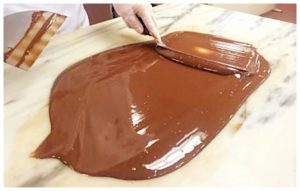 Untempered chocolate is heated to 45ºC, after which two thirds of the melted chocolate is poured onto a clean, cool marble or stone surface. The melted chocolate is spread and worked until the consistency starts to thicken and the temperature reaches 27ºC to 28ºC. At this point, the tempered chocolate is added back to the untempered chocolate and mixed in thoroughly to create the working chocolate.
Untempered chocolate is heated to 45ºC, after which two thirds of the melted chocolate is poured onto a clean, cool marble or stone surface. The melted chocolate is spread and worked until the consistency starts to thicken and the temperature reaches 27ºC to 28ºC. At this point, the tempered chocolate is added back to the untempered chocolate and mixed in thoroughly to create the working chocolate.
Seeding method
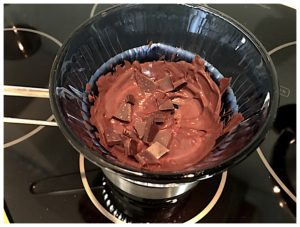 Untempered chocolate is heated to 45ºC. To the melted chocolate, another 25% of untempered chocolate is added. The mixture is stirred vigorously until all the chocolate has melted, to create the working chocolate.
Untempered chocolate is heated to 45ºC. To the melted chocolate, another 25% of untempered chocolate is added. The mixture is stirred vigorously until all the chocolate has melted, to create the working chocolate.
Microwave method
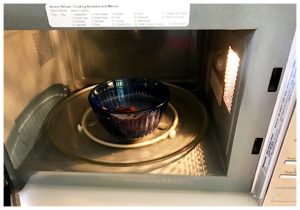 Untempered chocolate is heated in a microwave, in bursts of 30 seconds and while stirring in between, until the proportion of solid to melted chocolate is roughly 50:50. This mixture is then stirred until all the chocolate has melted, to create the working chocolate.
Untempered chocolate is heated in a microwave, in bursts of 30 seconds and while stirring in between, until the proportion of solid to melted chocolate is roughly 50:50. This mixture is then stirred until all the chocolate has melted, to create the working chocolate.
Bringing It All Together
Tempering creates the many favourable attributes that we all associate with good quality, well made chocolate. As a consumer, take the time to appreciate the unearthed truth about temper and the complex beauty of science each time you savour a mouthful of crisp, glossy and shiny chocolate!